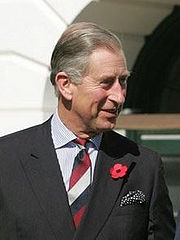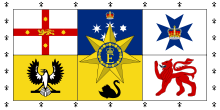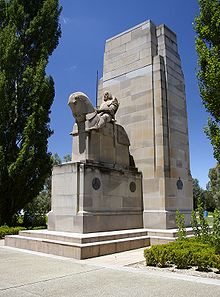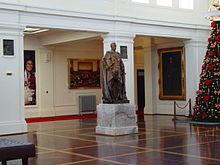- Monarchy of Australia
-
This article is about the monarchy of Australia. For information on the other countries which share the same monarchy, see Commonwealth realm.
Queen of Australia Monarchy Federal 
Coat of arms of Australia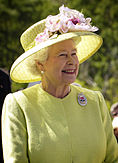
Incumbent:
Elizabeth IIStyle: Her Majesty Heir apparent: Charles, Prince of Wales First monarch: Queen Victoria Formation: 1 January 1901 Australia  This article is part of a series about the
This article is part of a series about the
Politics and government
of Australia• Queen (Elizabeth II)
• Constitution Act
• Statute of Westminster
• Australia ActExecutiveLegislativeJudicial• Federal electoral system
By-elections
• Electoral divisions
• Election of 1901 · 1903 - 1974 ·
1975 · 1977 · 1980 · 1983 · 1984 ·
1987 · 1990 · 1993 · 1996 · 1998 ·
2001 · 2004 · 2007 · 2010 · Next ·Executive
• Governors and Administrators
• Premiers and Chief Ministers
• NSW · Vic · Qld · WA · SA · Tas ·
ACT · NTLegislative
• Parliaments and Assemblies
• State electoral systems
The Monarchy of Australia is a form of government in which a hereditary monarch is the sovereign of Australia. The monarchy is a constitutional one modelled on the Westminster style of parliamentary government, incorporating features unique to the Constitution of Australia.
The present monarch is Elizabeth II, styled Queen of Australia, who has reigned since 6 February 1952. She is represented in Australia by the Governor-General, in accordance with the Australian Constitution and Letters Patent from the Queen.[1][2] In each of the states, the monarch is represented by a governor, appointed directly by the Queen on the advice of each of her respective state governments.
The Australian monarch, besides reigning in Australia, separately serves as monarch for each of fifteen other Commonwealth countries known as Commonwealth realms. This developed from the former colonial relationship of these countries to Britain, but they are now independent of each and legally distinct.
Contents
International and domestic aspects
- Further information: Commonwealth realm: The Crown in the Commonwealth realms
The monarch of Australia is the same person as the monarch of the fifteen other Commonwealth realms within the 54-member Commonwealth of Nations; however, each country is sovereign and independent of the others.[3] On all matters of the Australian state, the monarch is advised by Australian federal Ministers of the Crown[4][5] and, effective with the Australia Act 1986, no British government can advise the monarch on any matters pertinent to Australia. The British Government is thus considered a foreign power in regard to Australia's domestic and foreign affairs. Still, the High Court of Australia found that those natural-born subjects of other Commonwealth realms who migrated to Australia could not be classified as aliens (as referred to in the constitution) within Australia, given that they owed allegiance to the same monarch and thus are subjects of the Queen of Australia.[6] However, in Sue v Hill, the High Court of Australia found that the United Kingdom was a foreign power for the purposes of Section 44 of the Australian Constitution, which determines eligibility for parliamentary office.[7]
Title
Further information: List of titles and honours of Queen Elizabeth II and Australian peersThe shared and domestic aspects of the Crown are also highlighted in the sovereign's Australian title, currently Elizabeth the Second, by the Grace of God Queen of Australia and Her other Realms and Territories, Head of the Commonwealth. The Australian monarch has maintained the moniker of "Elizabeth the Second", even though she is the first Queen of Australia with that name. The sovereign's role specifically as Queen of Australia, as well as her status as monarch of other nations, is communicated by mentioning Australia separately from, but along with, the Queen's other lands. Typically, the sovereign is styled Queen of Australia and is addressed as such when in Australia or performing duties on behalf of Australia abroad. The sovereign is the only member of the Royal Family to have a title established through Australian law; other members are accorded a courtesy title, which is the title they have been granted via Letters Patent in the United Kingdom.
Prior to 1953, the title had simply been the same as that in the United Kingdom, the current form of the title being the result of occasional discussion and an eventual meeting of Commonwealth representatives in London in December 1952, at which Canada's preferred format for the monarch's title was: Elizabeth the Second, by the Grace of God, Queen of [Realm] and of Her other realms and territories, Head of the Commonwealth, Defender of the Faith;[8] however, Australia wished to have the United Kingdom mentioned as well.[9] Thus, the resolution was a title that included the United Kingdom but, for the first time, also mentioned Australia, and the other Commonwealth realms, separately. The passage of a new Royal Style and Titles Act by the parliament of Australia put these recommendations into law. This act was further amended in 1973, removing specific reference to the monarch's role as Queen of the United Kingdom. Still, laws pre-dating the Royal Styles and Titles Acts have not been amended to alter references to the Queen of the United Kingdom.[10]
Finance
Australians do not pay any money to the Queen, either for personal income or to support the royal residences outside of Australia. Only when the Queen is in Australia, or acting abroad as Queen of Australia, does the Australian government support her in the performance of her duties. This rule applies equally to other members of the Royal Family. Usually the Queen's Australian governments pay only for the costs associated with the governor-general and governors in their exercising of the powers of the Crown on behalf of the Queen, including travel, security, residences, offices and ceremonial occasions, etc.
Succession
Succession is by male-preference primogeniture governed by the provisions of the Act of Settlement 1701 and the Bill of Rights 1689. This legislation limits the succession to the natural (i.e. non-adopted), legitimate descendants of Sophia, Electress of Hanover, and stipulates that the monarch cannot be a Roman Catholic, nor married to one, and must be in communion with the Church of England upon ascending the throne. Though these constitutional laws, as they apply to Australia, lie within the control of the British parliament,[11] via adopting the Statute of Westminster, the UK agreed not to change its rules of succession without the unanimous consent of the other realms, unless explicitly leaving the shared monarchy relationship; a situation which applies symmetrically in all the other realms and which has been likened to a treaty amongst these countries.[12]
Upon a demise of the Crown (the death or abdication of a sovereign) it is customary for the accession of the new monarch to be publicly proclaimed by the governor-general on behalf of the Federal Executive Council, which meets at Government House, Canberra, after the accession. Parallel proclamations are made by the governors in each state.[13] Regardless of any proclamations, the late sovereign's heir immediately and automatically succeeds, without any need for confirmation or further ceremony; hence arises the phrase "The King is dead. Long live the King!" Following an appropriate period of mourning, the monarch is also crowned in the United Kingdom, though this ritual is not necessary for a sovereign to reign; for example, Edward VIII was never crowned, yet was undoubtedly king during his short time on the throne. After an individual ascends the throne, he or she typically continues to reign until death. There is no provision in the law for a monarch to unilaterally abdicate; the only Australian monarch to abdicate, Edward VIII, did so with the authorisation of the Australian government, granted in His Majesty's Declaration of Abdication Act, 1936.
Personification of the state
Further information: The CrownToday the sovereign is regarded as the legal personality of the Australian state, which is therefore referred to as Her Majesty the Queen in Right of Australia. For example, if a lawsuit is filed against the Commonwealth government, the respondent is formally described as Her Majesty the Queen in Right of Australia, or simply Regina. Likewise, in a case in which a party sues both the state of Queensland and the federal government, the respondents would formally be called Her Majesty the Queen in Right of Queensland and Her Majesty the Queen in Right of Australia.
As such, all state lands are called Crown land, state owned buildings and equipment are called Crown held property, and the copyright for all government publications is called Crown copyright. In this role, the monarch is also the locus of oaths of allegiance; many employees of the Crown are required by law to recite this oath before taking their posts, such as all members of the Commonwealth parliament, all members of the state and territorial parliaments, as well as all magistrates, judges and justices of the peace. This is in reciprocation to the sovereign's Coronation Oath, wherein he or she promises "to govern the Peoples of... Australia... according to their respective laws and customs".[14] Previously, new appointees to Cabinet would also swear an oath that included allegiance to the monarch before taking their post. This oath was never written in law, however, and would only take the form of what the prime minister of the time suggested to the governor-general. In December 2007, Kevin Rudd did not swear allegiance to the sovereign when sworn in by the Governor-General, making him the first prime minister not to do so;[15] however, he (like all other Members of Parliament) did swear allegiance to the Queen, as required by law, when sworn-in by the Governor-General as newly-elected parliamentarians. Similarly, the Oath of Citizenship contained a statement of allegiance to the reigning monarch until 1994, when a pledge of allegiance to Australia and its values was introduced. The High Court found, in 2002, though, that allegiance to the Queen of Australia was the "fundamental criterion of membership" in the Australian body politic, from a constitutional, rather than statutory, point of view.[6]
Constitutional role
“ We have a very good system now in terms of political stability... one of the reasons why we have had this wonderful stability is because of the constitutional linkages from Crown to Governor-General to Prime Minister at the Federal level, and Crown to Governor to Premiers at the State level. There are checks and balances in the system, and that is why we never had civil wars, that is why we never had huge political upheavals except in '32 and '75. So the system as it is has worked very well.[16] ” —Governor-General Michael Jeffery, 2003
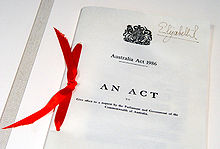 Australia Act 1986 (United Kingdom) document, located in Parliament House, Canberra, and bearing the signature of Elizabeth II, Queen of Australia.
Australia Act 1986 (United Kingdom) document, located in Parliament House, Canberra, and bearing the signature of Elizabeth II, Queen of Australia.
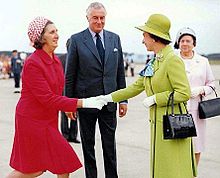 Elizabeth II is greeted by Margaret Whitlam at Fairbairn RAAF base, with Gough Whitlam, Prime Minister of Australia, and Lady Hasluck, wife of the then Governor-General, looking on.
Elizabeth II is greeted by Margaret Whitlam at Fairbairn RAAF base, with Gough Whitlam, Prime Minister of Australia, and Lady Hasluck, wife of the then Governor-General, looking on.
Australia's constitution is a written one, based on the Westminster model of government, with federal elements modelled on the United States Constitution and a distinct separation of powers. It gives Australia a parliamentary system of government similar to the other Commonwealth realms, wherein the role of the Queen and the Governor-General is both legal and practical. The Crown is regarded as a corporation, in which several parts share the authority of the whole, with the Queen as the person at the centre of the constitutional construct,[17] meaning all powers of state are constitutionally reposed in the monarch;[18] the 1993 Republic Advisory Committee concluded that "the Queen" in the constitution means "the Australian Government".[5] The sovereign is represented in the federal sphere by the Governor-General – appointed by the monarch on the advice of the Prime Minister of Australia – and in the states by governors – appointed by the monarch upon the advice of the relevant state premier.
There is some debate over whether the sovereign or the governor-general is Australia's head of state.[19]
Executive
In Australia's constitutional system, one of the main duties of the Governor-General is to appoint a prime minister, who thereafter heads the Cabinet and advises the governor-general on how to execute his or her executive powers over all aspects of government operations and foreign affairs. This means that the monarch's and the viceroy's roles are primarily symbolic and cultural, acting as a symbol of the legal authority under which all governments and agencies operate. In practice, ministers direct the use of the Royal Prerogative, which includes the privilege to declare war, maintain peace, and direct the actions of the Australian Defence Force. The governor-general is empowered by the Constitution to summon and prorogue parliament, and call elections; however the powers are almost never exercised without advice from the prime minister. Still, the Royal Prerogative belongs to the Crown, and not to any of the ministers and the governor-general may unilaterally use these powers in exceptional constitutional crisis situations,[20] such as when, during the 1975 Australian constitutional crisis, Sir John Kerr dismissed Prime Minister Gough Whitlam, on the occasion of a stalemate over government funding between the House of Representatives and the Senate. There are also a few duties which must be specifically performed by the Queen. These include signing the appointment papers of governors-general, the confirmation of the creation of awards of Australian honours,[21][22] and the approval of any change in her Australian title.
In accordance with convention, the governor-general, to maintain the stability of government, must appoint as prime minister the individual most likely to maintain the support of the House of Representatives: usually the leader of the political party with a majority in that house, but also when no party or coalition holds a majority (referred to as a minority government situation), or other scenarios in which the governor-general's judgement about the most suitable candidate for prime minister has to be brought into play.[23] The governor-general also appoints to Cabinet the other ministers of the Crown, who are, in turn, accountable to the Parliament, and through it, to the people. The Queen is informed by her viceroy of the acceptance of the resignation of a prime minister and the swearing-in of a new prime minister and other members of the ministry, and she holds audience with her Australian ministers where possible.[24]
Members of various executive agencies and other officials are appointed by the governor-general, including High Court justices. Ministers and parliamentary secretaries are also appointed to the Federal Executive Council. Public inquiries are also commissioned by the Crown through a Royal Warrant, and are called Royal Commissions. A casual vacancy in the Senate is filled by an appointee from the same political party by a state parliament or state governor.
Foreign affairs
The Royal Prerogative also extends to foreign affairs: the Governor-General-in-Council negotiates and ratifies treaties, alliances, and international agreements.[25] As with other uses of the Royal Prerogative, no parliamentary approval is required;[26] however, a treaty cannot alter the domestic laws of Australia; an Act of Parliament is necessary in such cases. The governor-general, on behalf of the Queen, also accredits Australian High Commissioners and ambassadors, and receives diplomats from foreign states. In addition, the issuance of passports falls under the Royal Prerogative, and, as such, all Australian passports are issued in the name of the governor-general as the monarch's representative.
Parliament
The sovereign, along with the Senate and the House of Representatives, being one of the three components of parliament, is called the Queen-in-Parliament. The authority of the Crown therein is embodied in the mace (House of Representatives) and Black Rod (Senate), which both bear a crown at their apex. The monarch and viceroy do not, however, participate in the legislative process save for the granting of Royal Assent by the Governor-General. Further, the constitution outlines that the Governor-General alone is responsible for summoning, proroguing, and dissolving parliament,[27] after which the writs for a general election are usually dropped by the Prime Minister at Government House. The new parliamentary session is marked by the State Opening of Parliament, during which either the monarch or the Governor-General reads the Speech from the Throne. As the monarch and viceroy, by convention, cannot enter the House of Representatives, this, as well as the bestowing of Royal Assent, takes place in the Senate chamber; Members of Parliament are summoned to these ceremonies from the House of Representatives by the Crown's messenger, the Usher of the Black Rod, after he knocks on the doors of the lower house that have been slammed closed on him to symbolise the barring of the monarch from the House of Representatives.
 The sovereign's throne to the left, and a seat for the Royal Consort to the right, in the Australian Senate.
The sovereign's throne to the left, and a seat for the Royal Consort to the right, in the Australian Senate.
All laws in Australia, except in the Australian Capital Territory (ACT) Legislative Assembly, are enacted only with the viceroy's granting of Royal Assent, done by the Governor-General or relevant Governor, with the Great Seal of Australia or the appropriate state seal, while territorial legislatures, unlike their state counterparts, are subject to the oversight of the Government of Australia. The Governor-General may reserve a bill "for the Queen's pleasure"; that is withhold his consent to the bill and present it to the sovereign for her personal decision. Under the constitution, the sovereign also has the power to disallow a bill within one year of the Governor-General having granted Royal Assent. The reference to the Queen in this section was intended as a reference to the monarch acting on the advice of his or her British Cabinet; however, with the passage of the Statute of Westminster and the Australia Acts, the power to disallow laws technically devolved to the Queen in a personal capacity.[28] This power, however, has never been used.
Courts
In the United Kingdom, the sovereign was deemed the fount of justice.[29][30] However, he or she does not personally rule in judicial cases,[29] meaning that judicial functions are normally performed only in the monarch's name. Criminal offences are legally deemed to be offences against the sovereign and proceedings for indictable offences are brought in the sovereign's name in the form of The Queen [or King] against [Name] (sometimes also referred to as the Crown against [Name]).[31][32] Hence, the common law holds that the sovereign "can do no wrong"; the monarch cannot be prosecuted in his or her own courts for criminal offences. Civil lawsuits against the Crown in its public capacity (that is, lawsuits against the government) are permitted; however, lawsuits against the monarch personally are not cognizable. In international cases, as a sovereign and under established principles of international law, the Queen of Australia is not subject to suit in foreign courts without her express consent. The prerogative of mercy lies with the monarch, and is exercised in the state jurisdictions by the governors,[33] who may pardon offences against the Crown, either before, during, or after a trial.
In addition, the monarch also serves as a symbol of the legitimacy of courts of justice, and of their judicial authority; sessions of the High Court, for example, are opened with the words "the High Court of Australia is now in session; God Save the Queen." In a practice dating back to colonial times, state courts traditionally display the arms of the sovereign in right of the United Kingdom, except in New South Wales, where some of these have been replaced with the state arms.
States and territories
Further information: Governors of the Australian statesIn accordance with the Australia Act 1986, the Queen has the power to appoint, on the advice of the relevant state Premier, a Governor in each of the Australian states, who themselves appoint executive bodies, as well as people to fill casual Senate vacancies, if the relevant state parliament is not in session, under the Great Seal of the State. The state Governors continue to serve as the direct representatives of the Queen, in no way subordinate to the Governor-General of the Commonwealth, and they carry out on her behalf all of the Queen's constitutional and ceremonial duties in respect of their respective state. The Northern Territory and the Australian Capital Territory resemble states in many respects, but are administered directly by the Commonwealth of Australia; an Administrator, appointed by the Governor-general upon the advice of the Commonwealth government, takes the place of a state governor in the Northern Territory. The Australian Capital Territory has no equivalent position.
Cultural role
Royal presence and duties
Further information: Royal visits to Australia and List of Commonwealth visits made by Queen Elizabeth IIMembers of the Royal Family have been present in Australia since the late 1800s, on military manoeuvres, for official tours, or as the vice-regal representative of the monarch. Queen Elizabeth II was the first reigning monarch of Australia to set foot on Australian soil on 3 February 1954. The Queen has visited the country sixteen times, usually on important milestones, anniversaries, or celebrations of Australian culture, while other royals have been asked to participate in lesser occasions. In these instances, when acting at the direction of the Australian Cabinet, they are doing so as monarch of Australia and members of the Australian Royal Family, respectively, and will carry out two types of duties:
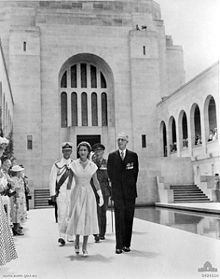 Elizabeth II tours the Australian War Memorial, February 1954
Elizabeth II tours the Australian War Memorial, February 1954
 The Princess Royal passes behind the Princess Anne Banner at a parade for the 75th anniversary of the Royal Australian Corps of Signals
The Princess Royal passes behind the Princess Anne Banner at a parade for the 75th anniversary of the Royal Australian Corps of Signals
Official duties involve the sovereign representing the state at home or abroad, or other Royal Family members participating in a government organised ceremony either in Australia or elsewhere.[34] The sovereign and/or his or her family have participated in events such as various centennials and bicentennials; Australia Day; the openings of Olympic and other games; award ceremonies; D-Day commemorations; anniversaries of the monarch's accession; and the like. Other royals have participated in Australian ceremonies or undertaken duties abroad, such as Prince Charles at the Anzac Day ceremonies at Gallipoli, or when the Queen, Prince Charles, and Princess Anne participated in Australian ceremonies for the anniversary of D-Day in France in 2004. On 22 February 2009, Princess Anne represented the Queen of Australia at the National Bushfires Memorial Service in Melbourne.[35][36] The Queen also showed her support for the people of Australia by making a personal statement about the bushfires [37] and by also making private donation to the Australian Red Cross Appeal.[38] The Duke of Edinburgh was the first to sign a book of condolences at the Australian High Commission in London.[38]
Unofficial duties are performed by Royal Family members on behalf of Australian organizations of which they may be patrons, through their attendance at charity events, visiting with members of the Australian Defence Force as Colonel-in-Chief, or marking certain key anniversaries. The invitation and expenses associated with these undertakings are usually borne by the associated organization.
Apart from Australia, the Queen and other members of the Royal Family regularly perform public duties in the other fifteen nations of the Commonwealth in which the Queen is sovereign. As the Crown within these countries is a legally separate entity from the Australian Crown, it is funded in these countries individually, through the ordinary legislative budgeting process.
Symbols
Main article: Australian Royal SymbolsThe monarchy is presently symbolised through images of the sovereign on currency and in portraits in public buildings; on Australian decorations and honours, some postage stamps and on coats of arms and other government symbols. The crown is used as a heraldic symbol in the coats of arms of the Commonwealth and the states of New South Wales, Victoria, Queensland and Western Australia. Crowns are also visible on police and military badges. The Queen's Birthday is observed as a public holiday in all states.
"God Save the Queen" is Australia's royal anthem. The Vice-Regal Salute, played only for the governor-general and each state sovernor, is the first four and last four bars of "Advance Australia Fair".
There are also hundreds of places named after Australian and British monarchs and members of the Royal Family. The states of Queensland and Victoria were named after Queen Victoria; Adelaide, the capital of South Australia is named after Queen Adelaide, the consort of William IV; numerous streets, squares, parks and buildings are also named in honour of past or present members of the Royal Family.
Religious role
Neither the Queen, the governor-general, or any state governor have any religious role in Australia. There never has been an established church in Australia, either before or since Federation in 1901. Pursuant to the Australian Constitution the Commonwealth may not enact a law establishing or prohibiting the free exercise of religion.[39] This is one of the key differences from the Queen's role in England where she is the Supreme Governor of the Church of England.
Vice-regal residences
The Governor-General's official residence is Government House, commonly known as "Yarralumla", in the city of Canberra. The Australian monarch stays there when visiting the country as do some other visiting heads of state.[40] Government House is the site of most state banquets, investitures, swearing-in of ministers, and other ceremonies. Another vice-regal residence is Admiralty House, in Sydney, and is used principally as a retreat for the Governor-General. The states of Victoria, Western Australia, Queensland, Tasmania, and South Australia also maintain residences, used by the respective Governors, though the monarch or other members of the Royal Family will stay there when in the state. These residences are the property of the Australian people administered by their federal and state governments.
Australian Defence Force
The Crown has a symbolic place in the Australian Defence Force, which consists of the Royal Australian Navy, Australian Army, and Royal Australian Air Force.
Section 68 of the Australian Constitution says: "The command in chief of the naval and military forces of the Commonwealth is vested in the Governor-General as the Queen's representative." In practice, however, the Governor-General does not play any part in the ADF's command structure and the ADF is under the control of the Minister for Defence and several subordinate ministers. The Minister advises the Governor-General who acts as advised in the normal form of executive government.[41]
Australian naval vessels bear the prefix Her Majesty's Australian Ship (HMAS). The Royal Australian Regiment (RAR) which makes up most of the Infantry Corps and many other regiments carry the 'Royal' prefix.[42] Members of the Royal Family have presided over military ceremonies, including Trooping of the Colours, inspections of the troops, and anniversaries of key battles. Whenever the Queen is in Canberra she lays a wreath at the Australian War Memorial. In 2003, Elizabeth II acted in her capacity as Australian monarch when she dedicated the Australian War Memorial in Hyde Park, London. [1]
Some members of the Royal Family are Colonels-in-Chief of Australian regiments, including: the Royal Regiment of Australian Artillery; Royal Australian Army Medical Corps; the Royal Australian Armoured Corps and the Royal Australian Corps of Signals, amongst many others. The Queen's husband, the Duke of Edinburgh, is an Admiral of the Fleet[43] in right of the Royal Australian Navy, Marshal of the Royal Australian Air Force, and Field Marshal of the Australian Army.
On 22 October 2011 at the Royal Military College, Duntroon in Canberra, the Queen of Australia presented new Sovereign's Colours to the Australian Defence Force.
History
Main article: History of monarchy in AustraliaThe development of a distinctly Australian monarchy came about through a complex set of incremental events, beginning with the initial settlements of the territory in 1770, when Captain James Cook, in the name of, and under instruction from, King George III, claimed the east coast of Australia.[44] Colonies were soon after founded across the continent,[45][46] all of them ruled by the monarch of the United Kingdom, upon the advice of his or her British ministers, the Secretary of State for the Colonies, in particular. After Queen Victoria's granting of Royal Assent to the Commonwealth of Australia Constitution Act on 9 July 1900, which brought about Federation in 1901, whereupon the six colonies became the states of Australia, the relationship between the state governments and the Crown remained as it was pre-1901: References in the constitution to "the Queen" meant the government of the United Kingdom (in the formation of which Australians had no say)[5] and the Colonial Laws Validity Act 1865 – by which colonial laws deemed repugnant to imperial (British) law in force in the colony were rendered void and inoperative – remained in force at in both the federal and state spheres;[47] and all the governors, both of the Commonwealth and the states, remained appointees of the British monarch on the advice of the British Cabinet,[48] a situation that continued even after Australia was recognised as a Dominion of the British Empire in 1907.[49] As Queen-Empress, Victoria "symbolised the British Empire of which all Australians were subjects".[5]
In response to calls from some Dominions for a re-evaluation in their status under the Crown after their sacrifice and performance in the First World War,[50] a series of Imperial Conferences was held in London, from 1917 on, which resulted in the Balfour Declaration of 1926, which provided that the United Kingdom and the Dominions were to be considered as "autonomous communities within the British Empire, equal in status, in no way subordinate to one another in any aspect of their domestic or external affairs, though united by a common allegiance to the Crown." The Royal and Parliamentary Titles Act, 1927, an Act of the Westminster Parliament, was the first indication of a shift in the law, before the Imperial Conference of 1930 established that the Australian Cabinet could advise the sovereign directly on the choice of Governor-General, which ensured the independence of the office.[51] The Crown was further separated amongst its dominions by the Statute of Westminster 1931,[52] and, though it was not adopted by Australia until 1942 (retroactive to 3 September 1939),[53] the law's validity in the United Kingdom required its government to seek Australia's consent in allowing the abdication of Edward VIII as King of Australia and all the other Dominions in 1936.
The Curtin Labor Government appointed Prince Henry, Duke of Gloucester, as Governor-General during the Second World War. Curtin hoped the appointment might influence the British to despatch men and equipment to the Pacific War, and the selection of the brother of King George VI reaffirmed the important role of the Crown to the Australian nation at that time.[54] Queen Elizabeth II became the first reigning monarch to visit Australia in 1954, greeted by huge crowds across the nation. Her son Prince Charles attended school in Australia in 1967.[55]Her grandson Prince Harry undertook a portion of his gap-year living and working in Australia in 2003.[56]
The sovereign did not possess a title unique to Australia until the Australian parliament enacted the Royal Styles and Titles Act in 1953, after the accession of Elizabeth II to the throne, and giving her the title of Queen of the United Kingdom, Australia and Her other Realms and Territories. Still, Elizabeth remained a queen who reigned in Australia both as Queen of Australia (in the federal jurisdiction) and Queen of the United Kingdom (in each of the states), as a result of the states not wishing to have the Statute of Westminster apply to them, believing that the status quo better protected their sovereign interests against an expansionist federal government, which left the Colonial Laws Validity Act in effect. Thus, the British monarch could still – at least in theory, if not with some difficulty in practice – legislate for the Australian states, and the viceroys in the states were appointed by and represented the sovereign of the United Kingdom, not that of Australia;[57] as late as 1976, the British ministry advised the Queen to reject the nominee of the Queensland Cabinet for Governor.[58] It was with the passage of the Australia Act in 1986, which repealed the Colonial Laws Validity Act, that the final vestiges of the British monarchy in Australia were removed, leaving a distinct Australian monarchy for the nation.
 Prince Charles, Prince of Wales, with students of his Australian alma mater, Geelong Grammar School, in Corio, Victoria.
Prince Charles, Prince of Wales, with students of his Australian alma mater, Geelong Grammar School, in Corio, Victoria.
It was around the same time that a discussion on the matter of Australia becoming a republic began to emerge, culminating, a decade later, in the 1999 Australian republic referendum, which was defeated by 54.4% of the populace. The referendum followed the recommendation of a 1998 Constitutional Convention called to discuss the issue of Australia becoming a republic. Still, nearly another ten years later, Kevin Rudd was appointed as Prime Minister, whereafter he affirmed that a republic was still a part of his party's platform, and stated his belief that the debate on constitutional change should continue.[59]
The current Prime Minister, Julia Gillard has re-affirmed her party's platform about a possible future republic. She stated that she would like to see Australia become a republic, with an appropriate time being when there is a change in monarch. A change of opinion was recorded on 21 October 2011 at a reception in the presence of the Queen at Parliament House in Canberra when the Prime Minister stated that the monarch is "a vital constitutional part of Australian democracy and would only ever be welcomed as a beloved and respected friend." [60] The Opposition Leader, Tony Abbott, a former head of Australians for Constitutional Monarchy stated on 21 October 2011, "Your Majesty, while 11 prime ministers and no less than 17 opposition leaders have come and gone, for 60 years you have been a presence in our national story and given the vagaries of public life, I'm confident that this will not be the final tally of the politicians that you have outlasted." [61]
A Morgan poll taken in October 2011 found that support for constitutional change is at its lowest for 20 years. Of those surveyed 34% were pro-republic as opposed to 55% pro-monarchist, preferring to maintain the current constitutional arrangements. [62]
See also
Other realms
Australia
- Australian Constitution
- List of Australian organisations with royal patronage
- Australian Peerages
Other
- Commonwealth realm
- States headed by Elizabeth II
- Prime Ministers of Queen Elizabeth II
- List of Commonwealth visits made by Queen Elizabeth II
Bibliography
- Smith, David I. (2005). Head of State – the Governor-General, the Monarchy, the Republic and the Dismissal; 1st ed.. Sydney: Macleay Press.
- Twomey, A. (2006). The Chameleon Crown – The Queen and her Australian Governors; 1st ed.. Sydney: The Federation Press.
Notes
- ^ Governor-General of the Commonwealth of Australia: Letters Patent Relating to the Office of Governor-General of the Commonwealth of Australia
- ^ Governor-General of the Commonwealth of Australia: Amendment of Letters Patent
- ^ R v Foreign Secretary; Ex parte Indian Association, QB 892 at 928; as referenced in High Court of Australia: Sue v Hill [1999] HCA 30; 23 June 1999; S179/1998 and B49/1998
- ^ Buckingham Palace: The Queen and Commonwealth: Australia
- ^ a b c d Report of the Republic Advisory Committee, Commonwealth Government Printer, Canberra, 1993, p29-30
- ^ a b Te and Dang (2002) 193 ALR 37 and Chu Keng Lim v Minister for Immigration, Local Government and Ethnic Affairs (1992) 176 CLR 1 at 54 as referenced in Parliament of Australia: Parliamentary Library: Prince, Peter; Research Paper no. 3 200304: We are Australian–The Constitution and Deportation of Australian-born Children; Law and Bills Digest Group; 24 November 2003
- ^ Twomey, Anne (2000). "Sue v Hill – The Evolution of Australian Independence". In Stone, Adrienne; Williams, George. The High Court at the crossroads: essays in constitutional law. New South Wales, Australia: Federation Press. ISBN 1862873712.
- ^ Documents on Canadian External Relations; Volume #15 - 2; Chapter 1, Part 2, Royal Style and Titles
- ^ Documents on Canadian External Relations; Volume #18 - 2; Chapter 1, Part 2, Royal Style and Titles
- ^ The Schedule of the Constitution sets forth the Oath of Allegiance and states it is to be sworn to 'the King or Queen of the United Kingdom of Great Britain and Ireland.'
- ^ Toporoski, Richard; Monarchy Canada: The Invisible Crown; Summer, 1998
- ^ Justice Rouleau in a 2003 court ruling wrote that "Union under the ... Crown together with other Commonwealth countries [is a] constitutional principle". O’Donohue v. Canada, 2003 CanLII 41404 (ON S.C.)
- ^ Greg Taylor (2006), The constitution of Victoria, Federation Press, p. 69
- ^ The Form and Order of Service that is to be performed and the Ceremonies that are to be observed in the Coronation of Her Majesty Queen Elizabeth II in the Abbey Church of St. Peter, Westminster, on Tuesday, the second day of June 1953
- ^ Shears, Richard (4 December 2007). "Australia's new PM is sworn in – but refuses to swear allegiance to the Queen". The Daily Mail (London: Associated Newspapers Ltd). http://www.dailymail.co.uk/pages/live/articles/news/worldnews.html?in_article_id=499369&in_page_id=1811.
- ^ Governor General of the Commonwealth of Australia: Transcript - World Today with Major General Jeffery - 23 June 2003
- ^ Cox, Noel; Murdoch University Electronic Journal of Law: Black v Chrétien: Suing a Minister of the Crown for Abuse of Power, Misfeasance in Public Office and Negligence; Volume 9, Number 3 (September 2002)
- ^ Accountable Government: A Guide for Ministers and Secretaries of State; Library and Archives Cataloguing in Publication; 2007; p. 49
- ^ "Crafting a Model Constitution – Monarchy or Republic?". Foundation for National Renewal. 3 May 2006. http://www.national-renewal.org.au/ModelCon/Task32/start.shtml. Retrieved 3 February 2008.
- ^ http://www.gg.gov.au/content.php/category/id/1/title/role
- ^ Australian Government: It's an Honour: Official Creation of Awards
- ^ Commonwealth of Australia Gazette; No. S 86, Monday, 30 May 2005
- ^ Office of the Governor-General of Australia. "About the Governor-General > Governor-General's role". Australian Government Publishing Service. http://www.gg.gov.au/content.php/category/id/1/title/role. Retrieved 16 March 2011.
- ^ Victorian Premier John Brumby has met Queen Elizabeth II in Scotland to discuss the impact of the February bushfires., ABC Online, 2009-10-06, accessed 29 October 2009
- ^ Australian Government Department of Foreign Affairs and Trade: Negotiating and Implementing Treaties
- ^ Australian Government Department of Foreign Affairs and Trade: Treaties, the Constitution and the National Interest
- ^ Australian Constitution section 5
- ^ Australian Constitution s 59
- ^ a b Gibbs, Harry; The Crown and the High Court - Celebrating the 100th birthday of the High Court of Australia; 17 October 2003
- ^ Buckingham Palace: Queen and the Law: Sovereign as 'Fount of Justice'
- ^ High Court of Australia Transcripts: Essenberg v The Queen B55/1999 (22 June 2000)
- ^ High Court of Australia: The Queen v Tang HCA 39 (28 August 2008)
- ^ [Section 475(1) Crimes Act 1900 (ACT)); ss 474B and 474C Crimes Act 1900 and s 26 Criminal Appeal Act 1912 (NSW); s 433A Criminal Code (Northern Territory); ss 669A, 672A Criminal Code 1899 (Queensland); s 369 Criminal Law Consolidation Act 1935 (South Australia); ss 398, 419 Criminal Code (Tasmania); s 584 Crimes Act 1958 (Victoria); s 21 Criminal Code and Part 19 Sentencing Act 1995 (Western Australia)
- ^ Buckingham Palace: Guidelines and Procedures for the Acceptance, Classification, Retention and Disposal of Gifts to Members of the Royal Family
- ^ Bushfires memorial echoes grief and hope - http://www.news.ninemsn.com.au/national/755462/thousands-to-mourn-vic-bushfire-dead
- ^ Princess Anne in bushfire tribute - http://news.bbc.co.uk/2/hi/uk_news/7904115.stm
- ^ http://www.royal.gov.uk/LatestNewsandDiary/Pressreleases/2009/TheQueensmessagefollowingthefiresinAustralia.aspx
- ^ a b http://www.royal.gov.uk/LatestNewsandDiary/Pressreleases/2009/ThePrincessRoyaltovisitareasaffectedbytheVictorian.aspx
- ^ Australian Constitution s 116[dead link]
- ^ "Government House". The Australiana Fund. http://www.theaustralianafund.org.au/government.html. Retrieved 14 April 2008.
- ^ Raspal Khosa (2004). Australian Defence Almanac 2004-05. Australian Strategic Policy Institute, Canberra. Page 4.
- ^ http://www.diggerhistory.info/pages-army-today/rar-sasr/0-rar-cat-index.htm
- ^ http://www.mlahanas.de/Greece/History/Portraits/PrincePhilip.html
- ^ Queen and Commonwealth: Australia: History
- ^ Day, D; Claiming a Continent; Harper Collins, 1997; p.38
- ^ B. Hunter (ed) The Stateman's Year Book, MacMillan Press, p.102 ff.
- ^ Craig, John; Australian Politics: A Source Book; second ed.; p.43
- ^ W.J. Hudson and M.P. Sharp, Australian Independence, pp. 4, 90
- ^ E.M. Andrews, The ANZAC Illusion, p.21
- ^ Blackshield, Tony and Williams, George Australian Constitutional Law and Theory (2nd edn 1998) p 143
- ^ David Smith, Head of State, Macleay Press 2005, p.24
- ^ Statute of Westminster 1931 (c. 4) s. 4; cf McInn, W.G.; A Constitutional History of Australia; p.152
- ^ Statute of Westminster Adoption Act 1942 (Cth) s 3 Craig, John; Australian Politics: A Source Book; p.43
- ^ http://adbonline.anu.edu.au/biogs/A140317b.htm?hilite=duke%3Bof%3Bgloucester
- ^ Magnay, Jacquelin (27 January 2011). "Prince Charles says 'Pommy' insults were character building". The Daily Telegraph (London). http://www.telegraph.co.uk/news/worldnews/australiaandthepacific/australia/8285474/Prince-Charles-says-Pommy-insults-were-character-building.html.
- ^ "Prince Harry arrives for gap year in Australia". BBC News. 23 September 2003. http://news.bbc.co.uk/cbbcnews/hi/world/newsid_3133000/3133262.stm.
- ^ Craig; p.43
- ^ Chipp, Don; An Individual View; p.144
- ^ Kevin Rudd reaffirms support for republic | PerthNow
- ^ Speech by Prime Minister of Australia, Julia Gillard, 21 October 2011, Parliament House
- ^ Address to a Reception for Her Majesty Queen Elizabeth II, Parliament House - Office of Tony Abbott, Leader of the Opposition, 21 October 2011
- ^ "Republic floats away as royal reign lingers" by Judith Ireland, The Canberra Times, 22 October 2011
References
- ^ National Archives of Australia: King George VI (1936–52)
- ^ National Museum of Australia: Royal Romance
- ^ National Archives of Australia: Royal Visit 1954
- ^ National Archives of Australia: Royal Visit 1963
- ^ National Archives of Australia: Prince Charles
- ^ Australian Government: Royal Visits to Australia
- ^ National Archives of Australia: Royalty and Australian Society
- ^ Yahoo News: Prince Edward to visit Vic fire victims
- ^ ABC News: Royal couple set for busy Aust schedule
- ^ Queen, Howard honour war dead
- ^ World leaders hail D-Day veterans
External links
- Governor-General of Australia
- Australians for Constitutional Monarchy
- The Australian Republican Movement
- The Australian Monarchist League
Commonwealth realms Current Former Ceylon · Fiji · Gambia · Ghana · Guyana · India1 · Ireland1 · Kenya · Malawi · Malta · Mauritius · Newfoundland2 · Nigeria · Pakistan · Rhodesia3 · Sierra Leone · South Africa · Tanganyika · Trinidad and Tobago · Uganda
1 Dominion, became republic before adoption of the term "realm"
2 Dominion, never ratified Statute of Westminster 1931, London-based external government 1934–1949, annexed by Canada in 1949
3 Southern Rhodesia unilaterally declared independence as Rhodesia in 1965, claiming to be a Commonwealth realm, but this was unrecognised by the United Kingdom. Rhodesia then declared itself a republic in 1970.Queen Elizabeth II Monarchies - Queen of Antigua and Barbuda
- Queen of Australia
- Queen of the Bahamas
- Queen of Barbados
- Queen of Belize
- Queen of Canada
- Queen of Grenada
- Queen of Jamaica
- Queen of New Zealand
- Queen of Papua New Guinea
- Queen of Saint Kitts and Nevis
- Queen of Saint Lucia
- Queen of Saint Vincent and the Grenadines
- Queen of the Solomon Islands
- Queen of Tuvalu
- Queen of the United Kingdom
- Prime Ministers
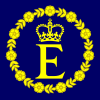
Titles and honours Overseas visits Public celebrations - Wedding to Philip, Duke of Edinburgh
- Coronation
- Silver Jubilee
- Golden Jubilee
- Diamond Jubilee
- Queen's Official Birthday
- Victoria Day
Constitution of Australia Chapters I: The Parliament · II: The Executive · III: Courts · IV: Finance and trade · V: The States · VI: New States · VII: Miscellaneous · VIII: Amendments
Sections 1 · 2 · 3 · 4 · 5 · 6 · 7 · 8 · 9 · 10 · 11 · 12 · 13 · 14 · 15 · 16 · 17 · 18 · 19 · 20 · 21 · 22 · 23 · 24 · 25 · 26 · 27 · 28 · 29 · 30 · 31 · 32 · 33 · 34 · 35 · 36 · 37 · 38 · 39 · 40 · 41 · 42 · 43 · 44 · 45 · 46 · 47 · 48 · 49 · 50 · 51 · 52 · 53 · 54 · 55 · 56 · 57 · 58 · 59 · 60 · 61 · 62 · 63 · 64 · 65 · 66 · 67 · 68 · 69 · 70 · 71 · 72 · 73 · 74 · 75 · 76 · 77 · 78 · 79 · 80 · 81 · 82 · 83 · 84 · 85 · 86 · 87 · 88 · 89 · 90 · 91 · 92 · 93 · 94 · 95 · 96 · 97 · 98 · 99 · 100 · 101 · 102 · 103 · 104 · 105 · 106 · 107 · 108 · 109 · 110 · 111 · 112 · 113 · 114 · 115 · 116 · 117 · 118 · 119 · 120 · 121 · 122 · 123 · 124 · 125 · 126 · 127 · 128
Powers under Section 51interstate trade and commerce · taxation · communication · defence · quarantine · fisheries · currency · banking · insurance · copyrights, patents and trademarks · naturalization and aliens · corporations · marriage · divorce · pensions · social security · race · immigration · external affairs · acquisition of property · conciliation and arbitration · transition · referral · incident
Amendments Category:Amendments to the Constitution of Australia · Referendums
Other documents Institutions Constitutional Conventions · Governor-General · Monarchy · Parliament · High Court · Inter-State Commission
Theories and
doctrinesResponsible government · Separation of powers · Federalism · Reserved State powers · Implied immunity of instrumentalities
Other topics Categories:- Commonwealth realms
- Government of Australia
- History of Australia
- Australian constitutional law
- Monarchy in Australia
- Current monarchies
Wikimedia Foundation. 2010.

